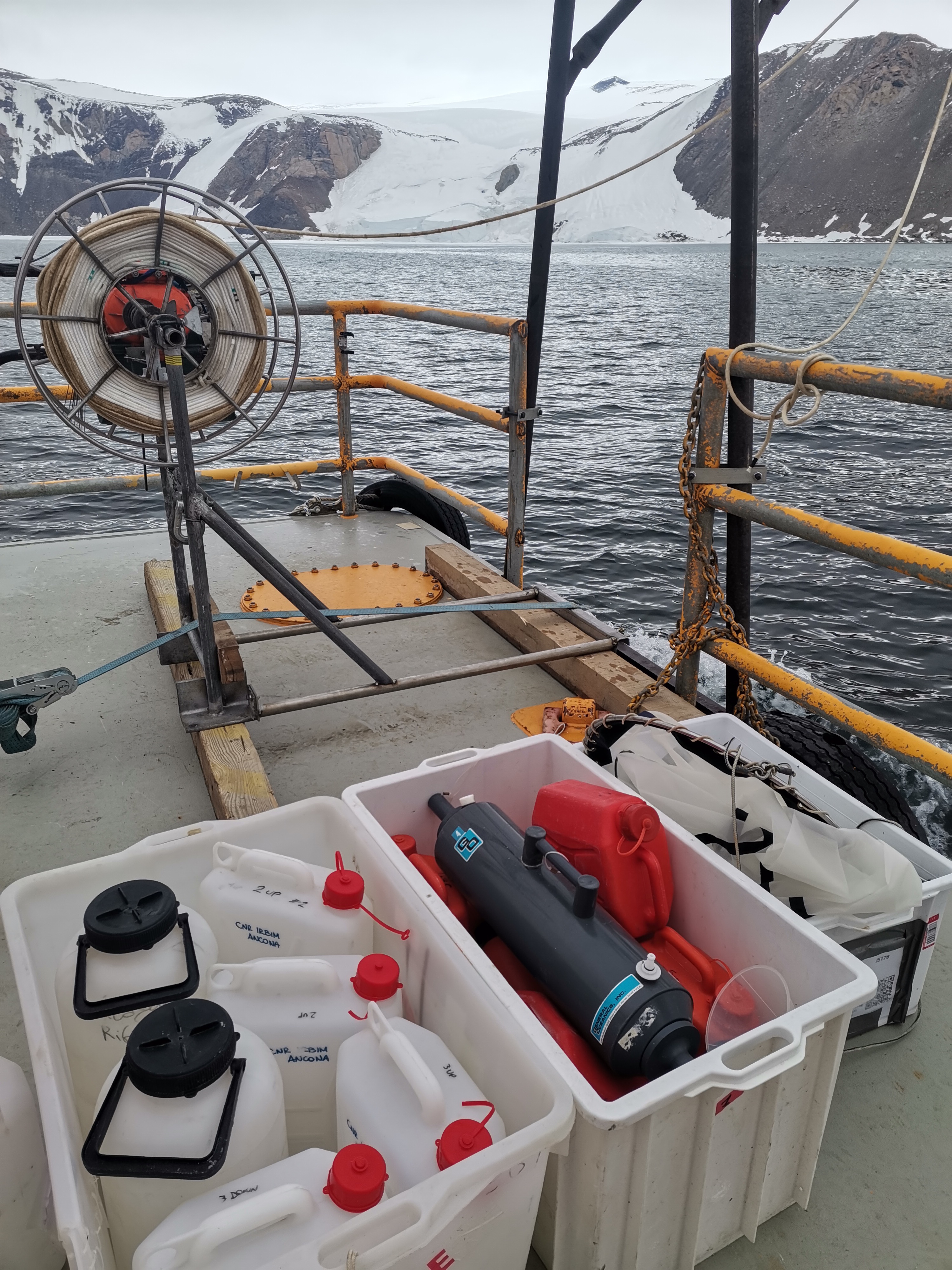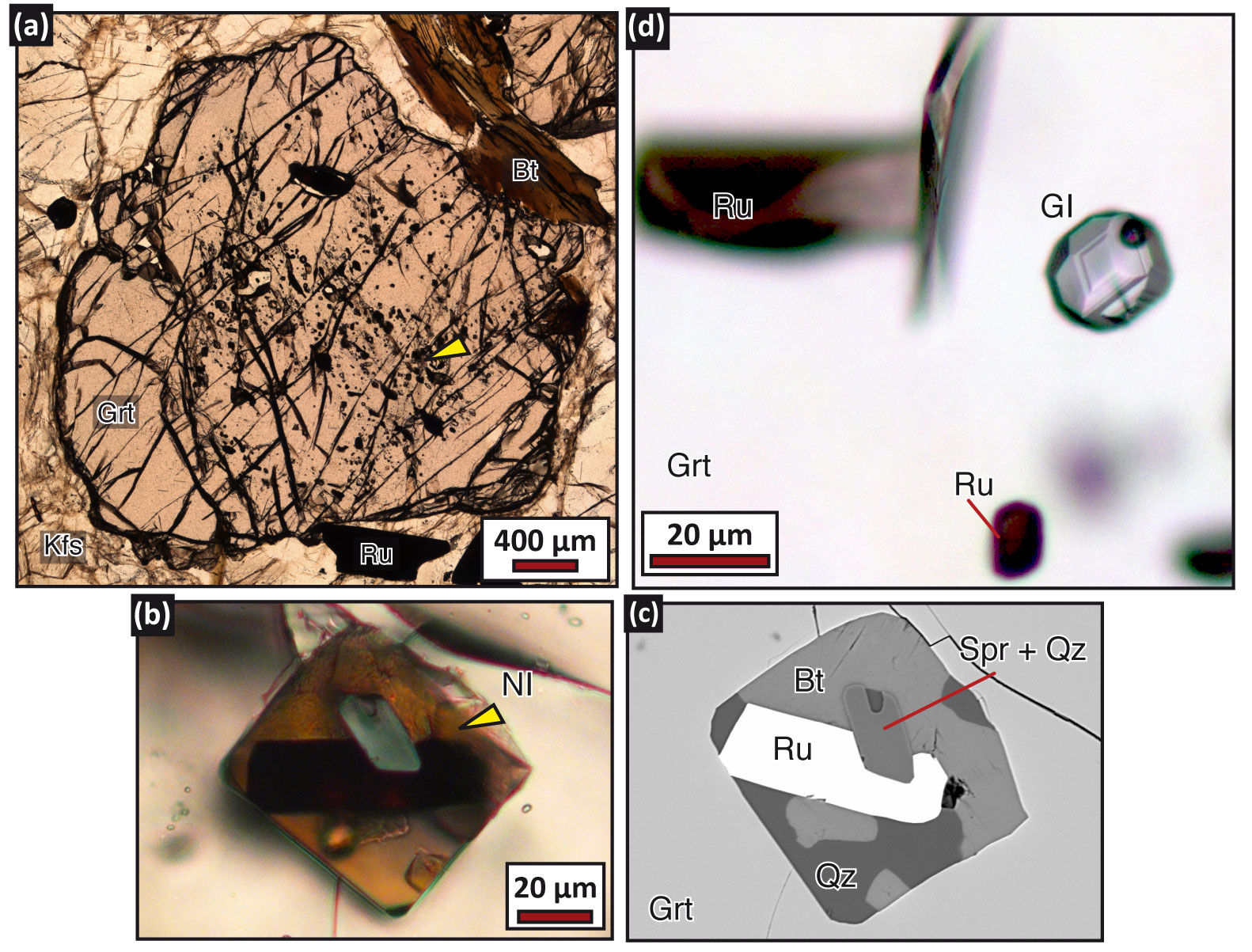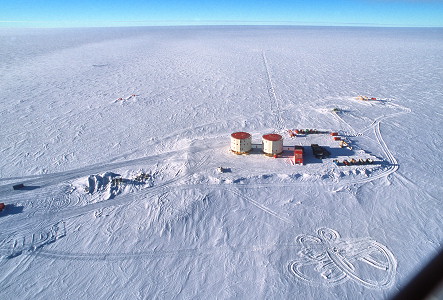dataset
Type of resources
Available actions
Topics
INSPIRE themes
Keywords
Contact for the resource
Provided by
Years
Formats
Representation types
Update frequencies
status
Scale
-
Antarctic ecosystems have a high number of species, that are closely linked to the presence of sea ice and seasonal cycles. This biodiversity is subject to anthropogenic and natural influences. Macrozoobenthic communities are the 'biological memory' of the ecosystem, structuring themselves as a function of environmental changes over the years. Macrozoobenthos samples were collected using suction dredging and scraping techniques, in soft and hard bottoms. Sampling occurred in 5 different sites.
-
Antarctic ecosystems have a high number of species, that are closely linked to the presence of sea ice and seasonal cycles. This biodiversity is subject to anthropogenic and natural influences. Zooplankton communities can provide a static snapshot of the health of the ecosystem. Zooplankton samples were collected with a 200 μm mesh net at 3 different sampling points at 80 m depth.
-
We will collect skin samples from the volunteers at the Mario Zucchelli Station at different time points, using safe and not harmfull kits. Samples will be analysed by shotgun metagenomic sequencing, considering only the microbial component.
-
Isotopic composition (Pb and Sr) in particulate matter (PM10) samples, collected at Concordia with monthly time resolution, since January 2018, obtained by ICP-MS.
-

The effects of sea ice melting, and the consequent changes in the trophic conditions in Antarctic ecosystems, have been focused on phytoplankton with cross-food web links from krill to penguins, while the consequences on the planktonic microbial food web (viruses, prokaryotes and unicellular eukaryotes), driving biogeochemical cycles, have been largely ignored. This research investigates how changes related to sea ice melting influence the diversity and functioning of planktonic microbes in the Ross Sea coastal ecosystem of Terranova Bay. The objectives are: i) to investigate the temporal changes of planktonic microbial biodiversity, ii) to investigate the biodiversity/ecosystem functioning relationships iii) to assess the role of viruses on biodiversity and biogeochemical cycles, iv) to identify the drivers that shape microbial biodiversity and functions, and v) to shed light on the interactions within the planktonic food web, and their response to the ice melting. META-ICE-ROSS integrates ad hoc sampling with sophisticated methodologies of high-throughput sequencing of microbial DNA (metagenomics), never documented in previous Italian expeditions at Terranova Bay. The sampling includes the collection of seawater beneath the pack ice at increasing distance from the MZ Station and characterised by different thermohaline conditions, on a weekly basis from early November to mid January. The groundbreaking nature of META-ICE-ROSS will allow to provide unprecedented evidences on the role of microbial interactions in the functioning of the Ross Sea coastal ecosystem, to improve knowledge on biological changes due to global climate changes and, nonetheless, to provide a baseline assessment of the functioning of the microbial food webs and carbon sequestration in the pelagic environment in the Ross Sea region, within the context of the Ross Sea Region Marine Protected Area (RSRMPA) and its monitoring and research plan.
-

Below the results obtained by the HOT ANTARCTICA project are presented. Results regarding geochemistry of crustal melts Main results obtained by the most prominent samples are described separately for each of the investigated terranes (Napier Complex, Lützow Holm Complex, Rauer Islands and Schrimacher Hills). The methodology employed during the work is also listed below: 1) Samples interrogated in this project were previously collected from Napier Complex (provided by the collaboration with Prof. Simon Harley, University of Edinburgh), Lützow Holm Complex (provided by the collaboration with Prof. Satish-Kumar, University of Niigata), Rauer Islands (provided by the collaboration with Prof. Simon Harley, University of Edinburgh and in collaboration with Zhao Liu, Northwest University ,China) and Schrimacher Hills (provided by the Museo Nazionale dell’Antartide, Siena, Italy). 2) Microstructural and petrographic study were done in all samples to identify equilibrium assemblages, melting reaction microstructures and occurrence of nanogranitoids (i.e. crystallized inclusions), melt and fluid inclusions. 3) Microstructural characterization of inclusions using Field Emission-Scanning Electron Microscope (FE-SEM) analyses were done: i) to identify the submicrometric phases within nanogranitoids and ii) to verify the homogeneity of remelted nanogranites and preserved glassy melt inclusions. 4) Experimental remelting of crystallized melt inclusions was performed to overcome the problem of MI decrepitation and volatile loss. The remelting of nanogranitoids was performed at high pressure with a piston cylinder apparatus using a QUICKpress piston cylinder apparatus produced by Depths of the Earth (installed at the Dipartimento di Geoscienze, UniPd). 5) Analysis of the major and trace elements contents of melt inclusions was carried out using i) an electron microprobe at the at University of Milan and ii) a LAICPMS at University of Perugia. 6) Thermodynamic modeling of anatectic conditions: the evaluation of P-T-X parameters and of P-T paths in the different geologic contexts were carried out using the software Perple_X. 7) Micro-Raman spectroscopy: characterization of fluid inclusions coexisting with melt inclusions was done using a HORIBA LabRam HR (high resolution) Raman microspectrometer at the University of Pavia. 8) Cross-comparison of data: during the development of this research project all collected data were analyzed by cross-comparing the information from the different geological contexts, with the aim to highlight similarities and differences. 9) Data discussion and evaluation: all data was analyzed and discussed in tight collaboration with the researchers involved in this project. 10) Synthesis and dissemination of results: dissemination of results was done with oral and poster presentations in several international conferences (see list on the appropriate section - Atti). Presentations include invited keynote presentations by the PI, Bruna Borges Carvalho at Goldschmidt (France, 2023) and Hutton Symposium (Italy, 2023). Invited seminars were also given in several important universities around the world [University of Bern, Switzerland; University of Cambridge, UK; University of Niigata, University of Kyoto, Japan]. Furthermore, a total of two research papers have been published in journals of high impact factor, and other two articles are in preparation. Here we also provide mineral, geochemical and geochronological data of studied areas at Rundvagshetta and Rauer Islands. Preprinted versions of two published article where the data is explained are also provided. Carvalho, B.B., Bartoli, O., Cesare, B., Satish-Kumar, M., Petrelli, M., Kawakami, T., Hokada, T., Gilio, M. (2023). Revealing the link between A-type granites and hottest melts from residual metasedimentary crust. Geology 51, 845-849. https://doi.org/10.1130/G51097.1 Liu, Z., Carvalho, B.B., Li, W., Tong, L., Bartoli, O., Li, C., Chen, L., ,Yan, Q, Wu, H. 2023. Into the high to ultrahigh temperature melting of Earth’s crust: Investigations of melt and fluid inclusions within Mg–rich metapelitic granulites from the Mather Peninsula, East Antarctica. Journal of Petrology 64, egad051. https://doi.org/10.1093/petrology/egad051 Results regarding petrology and geochronology of granulites In northern Victoria Land, the presence of two contrasting P-T paths suggests the possibility that high-grade complexes could have experienced a different metamorphic evolution both in space and time. Geochronological data of the Granite Harbour Intrusives support a prolonged magmatic activity (540-480 Ma), with multiple igneous pulses. This could imply the existence of magmatic underplating triggering the development of monometamorphic granulites during the Ross Orogeny. On the other hand, structural and PT evolution suggest the presence of a polymetamorphic granulitic belt that could be remnant of older orogeny as the Panafrican (ca. 600-500 Ma) (Lombardo et al., 1987; Palmeri, 1997; Talarico and Castelli, 1995). In order to discriminate mono- from poly-metamorphic evolution, metasedimentary granulite complex from the Deep Freeze Range has been investigated. Among all available granulite samples, a detailed petrographical study has been conducted to select the most representative and suitable HT granulite-facies rocks: four samples have been individuated for petrological and geochronological analyses (Opx-Grt and >30 µm Zrn/Mnz bearing), fifteen for geochemistry (absence of leucosome). In the Deep Freeze Range, HT granulites consist of Grt-Opx±Bt±Crd±Spl±Crn gneisses characterized by the presence of numerous Opx±Grt leucocratic segregations. Geochemical results confirm that analyzed granulite protholites have sedimentary origin, being comparable to Post Archean Australian Shale (PAAS; Taylor and McLennan, 1985), and they have been deposited in an orogenic setting (active continental margin). Petrographical, microstructural and mineral chemistry analyses show a metamorphic evolution including three different stages: Pl-Grt1-Spl-Crn-Ilm medium-P granulite facies (M1), Qtz-Pl-Opx-Grt1-Crd-Ilm-Kfs low-P granulite facies (M2), and Qtz-Pl-Grt2-Kfs-Bt-Ath low-P amphibolite (M3). Preliminary petrological results indicate that evolving metamorphic parageneses describe an initial isothermal decompression (exhumation event) followed by isobaric cooling; further thermodynamic modeling by software Perple_X will allow to better define P-T-X conditions. Geochronological studies involved the observation and analysis of monazites and zircons on four selected granulite thin sections. Investigations included X-ray mapping carried out under the electron microscope, CL-BSE imaging (zircons), and trace element analysis and U-Pb dating using LA-ICP-MS. Acquired data are still under review and will have a fundamental role in the reconstruction of the P-T-t path, thus making it possible to discriminate between mono- and poly-metamorphic hypotheses. References Lombardo et al 1987. Memorie della Società Geologica Italiana 33, 99-130. Palmeri R. 1997. Lithos 42, 47-66. Talarico and Castelli D. 1995. Precamb. Res. 75, 157-174. Taylor and McLennan S.M. 1985. Blackwell, Oxford, 312 p.
-
The current vision of global climatic changes stresses on the interlinked action of many factors, often more evident at regional scales. Polar regions are among the areas most sensitive to perturbations of the climate: through connections involving ocean, atmosphere, biosphere, lithosphere and cryosphere, they respond to, amplify, and drive changes elsewhere in the Earth system, so that understanding their role is essential. Peculiar characteristics of Polar Regions contribute to modify the energy and radiation budget, and the characteristics of the polar atmospheric boundary layer (ABL), increasing relevance at regional level of coupling processes between components of the climate system, especially in the coastal region. In particular, the long polar night, the sea-ice and snow coverage, favouring the persistency of stable atmospheric conditions, and the local and mesoscale circulation interactions, all affect the status and variability at different time scales of components of the regional climate system. Predicting future conditions of the polar regions is the goal of the Polar Prediction Project and of one of its key elements, the Year of Polar Prediction (YOPP, http://www.polarprediction.net/yopp.html), scheduled to take place from mid-2017 to mid-2019). This requires the scientific knowledge of their present status as well as a process-based understanding of the mechanisms of change. The parameterization of physical processes in regional and global hydrodynamical numerical models of the atmosphere is not yet enough accurate for a correct representation of all components of the climatic system and of their connections, the knowledge of which is needed to determine the role of polar regions in the global climate. As an example, more extended and integrated dataset are required to improve the parameterization of the ABL, for complex orography areas such as the polar coastal regions. The general scope of this project is to improve the understanding of the surface-atmosphere mass and energy exchanges at an Antarctic coastal site in the Ross Sea through continuous and accurate measurements of the atmospheric parameters, and development and verification of multiscale modelling, and through these activities, to address some of the relevant questions included in the roadmap for Antarctic and Southern Ocean science for the next two decades and beyond. Measurements will be carried out year-round at the new Korean Jang Bogo Antarctic Research Station (JBS), located at the coast of Terra Nova Bay, in the vicinity of the Italian Mario Zucchelli Station. Measurement and analysis of radiation components, atmospheric constituents and energy fluxes, meteorological and micrometeorological parameters, will be implemented jointly by Korea Polar Research Institute (KOPRI), CNR and UNIFI, in a way similar to the collaboration already active in the Arctic. Such implementation will be very useful to close a gap in the global climate observation system (GCOS) and contribute to WMO programs providing scientific data and information on meteorological and radiation regimes, vertical structure and chemical composition of the atmosphere.
-
The larval stages can be considered as the link from plankton to benthos. In order to study larval recruitment from zoobenthos, 40 tiles were placed at each of the four sites outlined in the project: Tethys Bay (control), Rod Bay (area subject to anthropogenic impact), Faraglione (control) and Adelie Cove (area subject to natural impact, linked to the presence of a penguin house). Due to adverse environmental factors all the tiles from Faraglione were lost and from Tethys Bay only half were found. The tiles were analysed with the help of a binocular, which enabled better visualisation of the organisms and, consequently, better identification.
-
De novo transcriptome analysis of Colobanthus quitensis Antarctic vascular plant grown under condition miming the global warm-up.
-

The research program aims to continue accurate measurements of surface radiative fluxes downwelling and upwelling at Dome-C, within the network Baseline Surface Radiation Network (BSRN https://bsrn.awi.de/), in order to provide broadband measurements of solar radiation short wave (in the three downwelling components direct, diffuse, global and in the global reflected fluxes) and thermal radiation (emitted from the atmosphere and from the surface). These measurements performed throughout the year provide complete information of the radiative regime in the East Antarctic Plateau, as well as its seasonal and interannual variability, and the radiative fluxes are an important input parameter for both the mass balance and regional climate models. In addition, the surface irradiance datasets are required to validate and calibrate at least 10-11 different satellite observations.